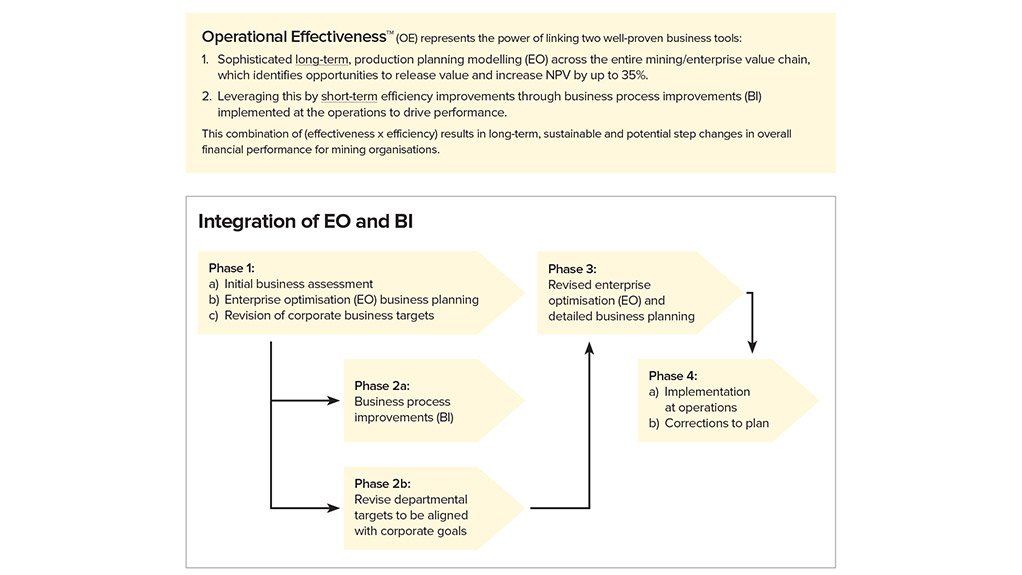Can Africa’s mining sector be refined to reach its full potential?
By: Steve Burks
In the three previous columns of this four-part series, I discussed potential methods to increase both the efficiency and effectiveness of operations and projects in the minerals industry in Africa, the objective being to increase their net present value (NPV). Many of the techniques discussed were developed by Whittle Consulting, an Australian niche consultancy with which MAC has a cooperative relationship. Ultimately, the outcome of the study is a report with recommendations that need to be implemented in order for the potential benefits to be realised.
There are significant opportunities for improvement in the mineral resources industry. The first step will involve in-depth interaction with the owners’ team and the compilation of the appropriate data, based on recent results or plans, into an input model. This is then used to apply Whittle Consulting’s methodology, philosophy and proprietary Prober software to simultaneously optimise the whole value chain of the operation.
The results of this study should then inform the executives tasked with the yearly planning process. In particular, the constraints and limitations applied by the optimisation team in its model will be explained fully, since it is these that determine how practicable the recommendations are likely to be.
The optimisation recommendations will also influence the strategic objectives identified, quantified and announced by the company’s executive management team. They will allow performance objectives to be aligned with the financial potential shown by the optimisation exercise for each major department.
The departmental management teams will then consider the efficiency improvements that could be essential to their sector of the value chain in terms of capacity and performance limits. In some cases, it can be expected that efficiency improvements, such as unit cost reductions or the achievement of ‘nameplate’ capacity in subordinate production units, will add further to the potential for NPV improvements. A revision of the optimised solutions to confirm this will probably be undertaken at this point.
Operational plans for each department that maximise efficiency while also achieving the revised strategic improvement targets will then be implemented.
I suggest that this process should make it possible for some fundamental weaknesses of the conventional minerals industry planning process to be addressed:
- the objectives and financial metrics set by the executive team can be tested to ensure that they are aligned to generate the optimal outcome for stakeholders;
- the qualitative objectives set can be defined using international benchmarks to ensure that there is a common understanding by all stakeholders and external observers;
- the corporate and departmental objectives specified in the process can be tested using the optimisation model to ensure that they are fully and positively aligned; and
- the fully aligned departmental objectives can be used to illustrate the dependence of departments on one another. A truly effective operation is likely to function differently from most ‘silo-based’ current operations and this process should be a tool to assist the necessary change management to achieve this.
The outcome, once the enhanced plan has been implemented, is expected to be a financial performance with an NPV at least 35% higher than the initial unoptimised plan, combining strategic optimisation and conventional efficiency improvements to achieve true operational effectiveness.
Steve Burks, an Associate Director of Johannesburg-based MAC Consulting, a management consulting group specialising in mining, oil and gas, financial services and telecommunications suggests that this could be the case, and offers some suggestions about how the situation might be improved. Prior to joining MAC Consulting, Burks had completed 30 successful optimisation studies over the past four years in Africa on behalf of Australia’s Whittle Consulting. This in turn followed nearly 20 years spent working for Bateman Engineering where Burks was involved in feasibility studies, project delivery, technology commercialisation, change management and business acquisitions and start-ups for mining related operations and projects in many countries.
Comments
Press Office
Announcements
What's On
Subscribe to improve your user experience...
Option 1 (equivalent of R125 a month):
Receive a weekly copy of Creamer Media's Engineering News & Mining Weekly magazine
(print copy for those in South Africa and e-magazine for those outside of South Africa)
Receive daily email newsletters
Access to full search results
Access archive of magazine back copies
Access to Projects in Progress
Access to ONE Research Report of your choice in PDF format
Option 2 (equivalent of R375 a month):
All benefits from Option 1
PLUS
Access to Creamer Media's Research Channel Africa for ALL Research Reports, in PDF format, on various industrial and mining sectors
including Electricity; Water; Energy Transition; Hydrogen; Roads, Rail and Ports; Coal; Gold; Platinum; Battery Metals; etc.
Already a subscriber?
Forgotten your password?
Receive weekly copy of Creamer Media's Engineering News & Mining Weekly magazine (print copy for those in South Africa and e-magazine for those outside of South Africa)
➕
Recieve daily email newsletters
➕
Access to full search results
➕
Access archive of magazine back copies
➕
Access to Projects in Progress
➕
Access to ONE Research Report of your choice in PDF format
RESEARCH CHANNEL AFRICA
R4500 (equivalent of R375 a month)
SUBSCRIBEAll benefits from Option 1
➕
Access to Creamer Media's Research Channel Africa for ALL Research Reports on various industrial and mining sectors, in PDF format, including on:
Electricity
➕
Water
➕
Energy Transition
➕
Hydrogen
➕
Roads, Rail and Ports
➕
Coal
➕
Gold
➕
Platinum
➕
Battery Metals
➕
etc.
Receive all benefits from Option 1 or Option 2 delivered to numerous people at your company
➕
Multiple User names and Passwords for simultaneous log-ins
➕
Intranet integration access to all in your organisation






















